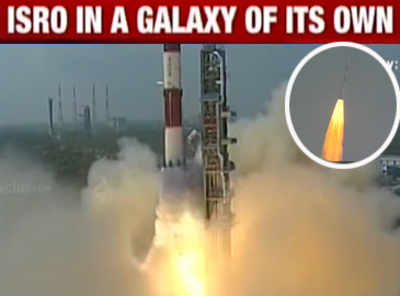- News
- India News
- Isro makes history, launches 104 satellites in single shot
Trending
This story is from February 16, 2017
Isro makes history, launches 104 satellites in single shot

SRIHARIKOTA: At about 10 am on Wednesday, India’s nearly 50-year-old space programme rocketed into the record books by successfully deploying as many as 104 satellites in orbit — a feat not accomplished by any country so far. This marked a huge leap from the Russian record of 37 (Isro’s previous highest was 20).
The historic mission has been six months in the making. It began at 9.28 am with a thunderous lift-off of the advanced version of the fourstage Polar Satellite Launch Vehicle, designated as PSLVC37, at the Satish Dhawan Space Centre, Sriharikota.After the launch both the President and PM Narendra Modi congratulated Isro. “This remarkable feat by Isro is yet another proud moment for our space scientific community and the nation. India salutes our scientists,” said Modi to Isro chairman A S Kiran Kumar on phone. The 104 satellites consisted of three Indian satellites — the 714kg Cartosat-2 series satellite along with two other Indian satellites and 101 international co-passengers which were For Isro, it was a giant leap from 20 to 104. On June 22 2016, it had placed 20 satellites in orbit in a single shot which gave it confidence to raise the number of satellites it can fly. In Wednesday’s mission, the total weight of all the 104 satellites flown was 1,378 kg. “It is not about setting records. It is primarily about improving our productivity to maximise our returns,” said Isro chairman AS Kiran Kumar.
Considering the complex nature of the mission, in the moments prior to take-off, the mood among the scientists and engineers in the mission control room was a mix of confidence and a degree of apprehension. About 30 minutes before launch, the weather was a ‘go’, and a few minutes later came an announcement that mission computers and all tracking stations were ready for the flight. “The PSLV-C37 mission is ready for launch,” the vehicle director informed mission director B Jayakumar.
With 15 minutes to go, Jayakumar declared that all systems were a “go” and gave the green signal to authorise the launch sequence. Ten minutes before the lift-off, the automatic launch system was activated, which means that all the launch activities were taken over by computers. All external power for the rocket was withdrawn and the on-board computers were put into flight mode. Then came the much-awaited countdown. The rocket with its precious cargo emerged through the thick jungle around the launch pad. For a few moments, it was soundless. “Lift-off normal,” an official from the mission control room announced. As the rocket pierced the morning sky leaving behind a yellowish plume of smoke, the area reverberated to the thunder and roar of the vehicle. Nearly 17 minutes and 30 seconds into the mission,the indigenous Cartosat-2 series satellite separated, evoking loud applause in the mission control room. Within seconds, the other two Indian satellites, Isro nanosatellites, went into orbit.
The historic mission has been six months in the making. It began at 9.28 am with a thunderous lift-off of the advanced version of the fourstage Polar Satellite Launch Vehicle, designated as PSLVC37, at the Satish Dhawan Space Centre, Sriharikota.After the launch both the President and PM Narendra Modi congratulated Isro. “This remarkable feat by Isro is yet another proud moment for our space scientific community and the nation. India salutes our scientists,” said Modi to Isro chairman A S Kiran Kumar on phone. The 104 satellites consisted of three Indian satellites — the 714kg Cartosat-2 series satellite along with two other Indian satellites and 101 international co-passengers which were For Isro, it was a giant leap from 20 to 104. On June 22 2016, it had placed 20 satellites in orbit in a single shot which gave it confidence to raise the number of satellites it can fly. In Wednesday’s mission, the total weight of all the 104 satellites flown was 1,378 kg. “It is not about setting records. It is primarily about improving our productivity to maximise our returns,” said Isro chairman AS Kiran Kumar.
Considering the complex nature of the mission, in the moments prior to take-off, the mood among the scientists and engineers in the mission control room was a mix of confidence and a degree of apprehension. About 30 minutes before launch, the weather was a ‘go’, and a few minutes later came an announcement that mission computers and all tracking stations were ready for the flight. “The PSLV-C37 mission is ready for launch,” the vehicle director informed mission director B Jayakumar.
With 15 minutes to go, Jayakumar declared that all systems were a “go” and gave the green signal to authorise the launch sequence. Ten minutes before the lift-off, the automatic launch system was activated, which means that all the launch activities were taken over by computers. All external power for the rocket was withdrawn and the on-board computers were put into flight mode. Then came the much-awaited countdown. The rocket with its precious cargo emerged through the thick jungle around the launch pad. For a few moments, it was soundless. “Lift-off normal,” an official from the mission control room announced. As the rocket pierced the morning sky leaving behind a yellowish plume of smoke, the area reverberated to the thunder and roar of the vehicle. Nearly 17 minutes and 30 seconds into the mission,the indigenous Cartosat-2 series satellite separated, evoking loud applause in the mission control room. Within seconds, the other two Indian satellites, Isro nanosatellites, went into orbit.
End of Article
FOLLOW US ON SOCIAL MEDIA










